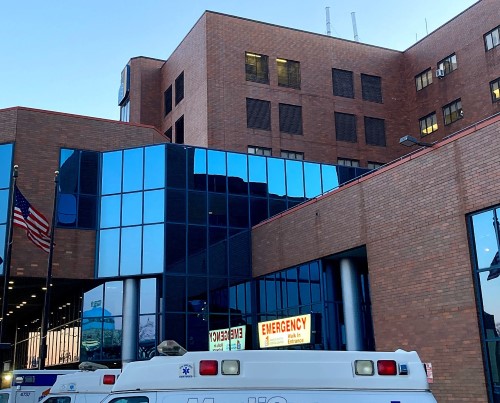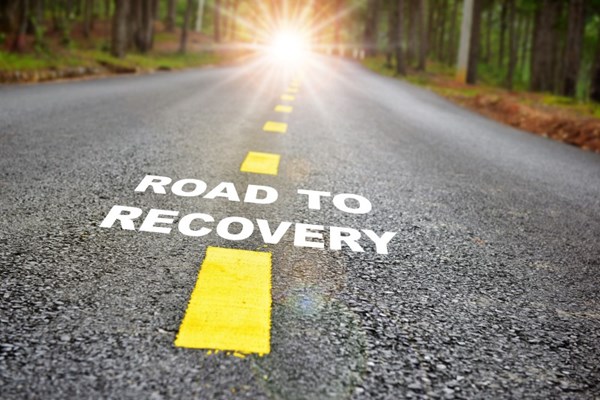An Emergency Department in Queens Responds to the Opioid Epidemic
In the heart of Queens, NY, in one of the most ethnically diverse counties in the world, exists an emergency department of a safety-net hospital and Level I trauma center: the Jamaica Hospital Medical Center ED.
Anthony Almeida, DO, an emergency medicine attending physician there, is responding to a young patient who has come in with severe opioid withdrawal symptoms. Holding her abdomen, pale and fatigued, she explains her story to Dr. Almeida, who calms her and assures he will help her feel better. He then goes back to his desk, and as he is inputting his notes into the EMR, I see a laminated sheet on his desk, reading “Suboxone Initiation Protocol in the ED.”
In 2020, drug overdose deaths in the United States reached 93,331, a 30 percent increase from 2019 and the highest single-year increase recorded.1 In 2021, the total number of drug overdose deaths in the United States reached a record of 107,622.2
According to the New York State Department of Health 2022 Report on Opioid-Related Deaths, 12 New York residents died every day during 2020 from an opioid overdose.3 Also that year, New York City boroughs were among the highest in opioid overdose ED visits and naloxone administrations by EMS.3
These trends in overdose deaths have accompanied the growing use of fentanyl, a potent synthetic opioid, which is now more often mixed with stimulants like cocaine and methamphetamine.4,5
Dr. Almeida, who has been working at the Jamaica Hospital ED since 2019, completed his training in emergency medicine at the New York Medical College-Metropolitan/Harlem residency program in Manhattan.
“Where I trained, I used to encounter opioid use and overdoses in the community all the time,” he says. “Since then, I have been interested in helping people manage their pain, and for me, opioid harm reduction is just the natural next step.”
In 2021, a group of emergency physicians at Jamaica Hospital, led by Melvin Ku, MD, developed the hospital’s buprenorphine-naloxone initiation protocol. Dr. Almeida explains that with this protocol, emergency physicians address patients’ withdrawal symptoms and begin the conversation of buprenorphine-naloxone treatment for opioid use disorder (OUD). Once buprenorphine-naloxone treatment is initiated, the ED provides a three-day supply of the medication and creates follow-up at the outpatient clinic of the hospital for further management.
Initiating Medication-Assisted Treatment in the ED
Emergency departments play a key role in addressing the opioid epidemic. As the ED is very often the first point of entry into the health care system for people who use opioids, emergency physicians have the unique opportunity to introduce patients to medication-assisted treatment (MAT) for OUD and significantly impact their addiction management.6 The initiation of MAT in the ED has been shown to significantly decrease mortality within a year of treatment.7 Previous research suggests that initiating MAT in the ED can be cost-effective and may increase the 30-day treatment engagement rates compared to just standard referral.8
Several EDs in the country have been using MAT initiation protocols for OUD, specifically buprenorphine protocols.6 Dr. Almeida explains that Jamaica Hospital uses buprenorphine-naloxone (brand name: Suboxone) for its MAT protocol, citing its “decreased potential for abuse, compared to buprenorphine alone.”
Suboxone, the brand-name medication, is composed of buprenorphine and naloxone and has been approved as a safe and effective MAT for opioid addiction, especially when combined with counseling and behavioral therapy.9Buprenorphine is an FDA-approved partial opioid agonist that decreases the effects of euphoria and respiratory depression caused by opioids, while also diminishing the symptoms of physical dependency and cravings caused by opioid withdrawal. Naloxone is an FDA-approved opioid antagonist that completely blocks the effects of opioids and can rapidly reverse opioid overdose.10 Suboxone carries the beneficial effects of buprenorphine, while the naloxone component decreases the likelihood of misusing the medication.
The ED as a Link to OUD Treatment and Care
When asked about the success of initiating buprenorphine-naloxone treatment in the ED among patients with OUD, Dr. Almeida says participation has been mixed.
“Getting people to start Suboxone has been a bit difficult,” he says, “mainly because of patients’ previous experiences with the health care system, but also because of their peers’ experiences with MAT.”
What makes Jamaica Hospital unique and, ultimately, affects how the MAT program is received, is the demographic make-up of its patient population.
“It is a high-acuity hospital in a predominantly underserved area, with many patients coming to the ED to establish care,” says Dr. Almeida.

Jamaica Hospital Medical Center
Indeed, most patients at the Jamaica Hospital ED are either uninsured or on Medicaid, and the majority are black, South Asian, or East Asian immigrants, many of whom are undocumented. Communities of color in the U.S. historically have faced medical discrimination and intersectional/intergenerational stigmatization that their white counterparts cannot relate to.11 As addiction carries a pervasive history of stigmatization, the added layer of medical racism significantly affects how people of color with a history of addiction will interact with the medical system.
Dr. Almeida adds, “Such a large proportion of patients here is underserved, and if I can help alleviate stigma surrounding opioid use and help link people to care, I am here for it.”
When asked about patient follow-up in the outpatient clinic, Dr. Almeida says it has been difficult.
He says, “Ideally, all patients started on Suboxone here in the ED will follow up with their appointments in our outpatient clinic. That hasn’t been the case, though. It’s hard — I would really want to help make that possible.”
In October 2022, only 12 people consented to receive buprenorphine-naloxone treatment in the Jamaica Hospital ED and were able to go to the outpatient clinic and continue their treatment. Dr. Almeida says that “even if the number of patients following up is small, it matters. Every one of these patients matters!”
Patient and Provider Education Regarding MAT
The design of the buprenorphine-naloxone initiation protocol at Jamaica Hospital has motivated emergency physicians to become more knowledgeable and educated in the provision of MAT and the intricacies of providing for people with OUD.
“We get the whole gamut of patients here. We help patients who have tried other programs and have been to rehabilitation or detoxification multiple times. We get a lot of people requesting Suboxone, but we also get people who have never heard of Suboxone or buprenorphine, so I’m able to also educate patients right here in the ED,” says Dr. Almeida.
He and his colleagues completed the Drug Enforcement Agency’s eight-hour X-Waiver course, a former requirement for qualified practitioners to obtain and prescribe buprenorphine.12 Dr. Almeida adds that “with this program, more ED providers are getting comfortable prescribing Suboxone and managing patients with opioid use, which has helped get more patients educated about these harm reduction methods as well.”
Ultimately, the purpose of initiating buprenorphine-naloxone treatment in the ED is to help patients who are ready to start treatment and educate them about their options. Introducing buprenorphine-naloxone as an option in the ED while linking patients with opioid addiction to follow-up care is a significant step in destigmatizing opioid use and addiction. With such programs becoming prevalent in EDs across the nation, the nature of discussions on addiction and harm reduction is shifting, creating a more humane and patient-centered way of managing substance use.
“At the end of the day, I want to help people feel a bit better,” says Dr. Almeida. “If they are ready for Suboxone, I am grateful to help them in their journey. If they are not ready, I am here for that as well.”
References
Editor's note: In January 2025, the U.S. government removed health information from public view. The cited data from the Substance Abuse and Mental Health Services Administration can now be found at https://www.rehab4addiction.co.uk/blog/subutex-vs-suboxone.
- Katz J, Sanger-Katz M. “It’s Huge, It’s Historic, It’s Unheard-of”: Drug Overdose Deaths Spike. The New York Times. Published July 14, 2021. Accessed December 10, 2022. https://www.nytimes.com/interactive/2021/07/14/upshot/drug-overdose-deaths.html
- U.S. Overdose Deaths In 2021 Increased Half as Much as in 2020 - But Are Still Up 15%. www.cdc.gov Published May 11, 2022. Accessed December 10, 2022. https://www.cdc.gov/nchs/pressroom/nchs_press_releases/2022/202205.htm
- The New York State Department of Health Announces Quarterly Opioid Report and Increased Actions to Prevent Opioid Overdose Statewide. www.health.ny.gov. Published April 4, 2022. Accessed December 10, 2022. https://www.health.ny.gov/press/releases/2022/2022-04-04_qtr_opioid_report.htm#:~:text=Drug%2Dinvolved%20overdose%20deaths%20increased,deaths%20every%20day%20during%202020.
- Weiland N, Sanger-Katz M. Overdose Deaths Continue Rising, With Fentanyl and Meth Key Culprits. The New York Times. https://www.nytimes.com/2022/05/11/us/politics/overdose-deaths-fentanyl-meth.html. Published May 11, 2022. Accessed December 10, 2022.
- Law T. Why Overdose Deaths Have Increased. Time. Published September 19, 2022. Accessed December 10, 2022.https://time.com/6214811/overdose-deaths-opioid-prescriptions/
- Substance Abuse and Mental Health Services Administration: Use of Medication-Assisted Treatment in Emergency Departments. HHS Publication No. PEP21-PL-Guide-5 Rockville, MD: National Mental Health and Substance Use Policy Laboratory. Substance Abuse and Mental Health Services Administration, 2021.
- Larochelle MR, Bernson D, Land T, et al. Medication for Opioid Use Disorder After Nonfatal Opioid Overdose and Association With Mortality: A Cohort Study. Ann Intern Med. 2018;169(3):137-145. doi:10.7326/M17-3107
- Hawk K, McCormack R, Edelman EJ, et al. Perspectives About Emergency Department Care Encounters Among Adults With Opioid Use Disorder. JAMA Netw Open. 2022;5(1):e2144955. Published 2022 Jan 4. doi:10.1001/jamanetworkopen.2021.44955
- Substance Abuse and Mental Health Services Administration. www.samhsa.gov Published September 27, 2022. Accessed December 10, 2022. https://www.samhsa.gov/medication-assisted-treatment/medications-counseling-related-conditions/buprenorphine
- Substance Abuse and Mental Health Services Administration. www.samhsa.gov. Published September 27, 2022. Accessed December 10, 2022. https://www.samhsa.gov/medication-assisted-treatment/medications-counseling-related-conditions/naloxone
- Suite DH, La Bril R, Primm A, Harrison-Ross P. Beyond misdiagnosis, misunderstanding and mistrust: relevance of the historical perspective in the medical and mental health treatment of people of color. J Natl Med Assoc. 2007;99(8):879-885.
- Substance Abuse and Mental Health Services Administration. Become a Buprenorphine Waivered Practitioner. www.samhsa.gov. Published April 21, 2022. Accessed December 10, 2022. https://www.samhsa.gov/medication-assisted-treatment/become-buprenorphine-waivered-practitioner



